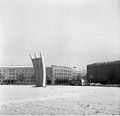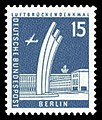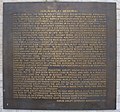Airlift Monument
Coordinates: 52 ° 29 ′ 2.8 ″ N , 13 ° 23 ′ 14.6 ″ E
The airlift monument (also mockingly: “hunger rake”) is the name given to three sculptures built according to plans by Eduard Ludwig (1906–1960) in Berlin , Frankfurt am Main and Celle , which are intended to commemorate the Berlin airlift with its victims.
The Berlin memorial was originally planned as a single piece. Duplicates corresponding to the Berlin sculpture were created in 1985 at the former Rhein-Main Air Base on the grounds of Frankfurt Airport and - in a somewhat smaller version - at the former Royal Air Force station in Celle (today: Celle Army Air Base ).
Berlin-Tempelhof Airlift Memorial
The first airlift monument ( coordinates ) was erected in 1951 in Berlin on the airlift square directly in front of Tempelhof Airport . In Berlin vernacular it is also known as the "hunger rake" or "hunger claw".
The three struts (“claws”) of the monument , which is oriented towards the west , symbolize the three air corridors between West Berlin and what was then the Trizone (later the Federal Republic of Germany ). The inscription on the round base reads: "You gave your life for the freedom of Berlin in the service of the Airlift 1948/1949". Below this are the ranks and names of all those who died in the accidents.
When the airport was closed at the end of October 2008, the last two take-offs were reserved for a Douglas DC-3 cherry bomber and the Junkers Ju 52 / 3m “Berlin-Tempelhof” operated by Lufthansa .
Airlift Memorial Frankfurt am Main
The air bridge monument in Frankfurt ( coordinates ) was founded on June 26, 1985 on the initiative of the Luftbruecke Chapter of the Airlift Tanker Association e. V. , who collected 940,000 marks for this (adjusted for purchasing power in today's currency: around 857,000 euros). A memorial and the names of the victims are recorded on metal plates on the base. Next to the memorial are a Douglas C-47 and a Douglas C-54 - types of aircraft that played a major role in the airlift. The C-54 is the aircraft with the number 44-9063 that rolled out of the production hall on March 16, 1945. In February 1946 it was converted to a commercial aircraft and flew for Pan Am , even in 1948. It was thus not involved in the Berlin Airlift, but made it to Europe in 1952 as HB-ILU with Swissair and 1959-1969 with Balair . In 1964 it was used in the filming of the film Flight in Danger . After various changes of owner, the machine came back from South Africa to Switzerland in 1987 , from where it came to Frankfurt in 1988.
For a long time, the memorial was only accessible to the public at certain times and outside of these opening times could only be viewed through the airport fence (from the A5 or via a footpath). After restoration work, it has been regularly accessible to visitors again since September 12, 2008, accessible via a cycle path from Terminal 2 or from Zeppelinheim.
On September 25, 2015, the ensemble was supplemented by the “Berlin Milestone”, a stone that indicates that the distance from the Frankfurter Kreuz to Berlin is 550 kilometers. Originally, the stone had stood between the A 5 lanes since 1958 and had to give way to a widened lane in 1970.
Celle Airlift Memorial

The airlift monument in Celle-Wietzenbruch ( coordinates ) was inaugurated on June 24, 1988, exactly 40 years after the Berlin blockade began, by the city of Celle and high-ranking guests from Germany, the USA , Great Britain and France . It is on Landesstraße 310 at the junction to Celle Air Base.
The construction was requested on September 10, 1985 by the then Celle council member Karl Duffner at the city administration of Celle in view of the 40th anniversary of the Berlin blockade to commemorate its victims and the role of the air base in Wietzenbruch and the building construction department as 13.5 tons heavy and six and a half meter high replica of the Berlin airlift memorial.
With the three symbolic “claws”, the structure points towards Berlin. The surrounding area is open to the public and is laid out like a park. Karl Duffner died in December 1987, six months before his idea was completed.
gallery
Postage stamp (1956) from the series Berlin Cityscapes
Aerial view of the airlift memorial on the Rhein-Main Air Base , August 1985
Web links
- Frankfurt Airlift Monument on the online portal for Groß-Gerau and Rhein-Main
- Entry in the Berlin State Monument List
- Airlift project , documents on the Berlin blockade and airlift
- Airlift monument open to visitors every day
Remarks
-
↑ The memorial reads:
On 26 June 1948 the Berlin Airlift officially began to provide food, fuel and medicine to 2.5 million West Berliners cut off from the world by a Soviet Union imposed blockade of all surface transportation. By the declared end of the "Big Lift" on September 30, 1949, 277,264 flights had been conducted from West Germany to West Berlin delivering in excess of 2.3 million tons. On the first day 32 C-47 aircraft carried 80 tons of supplies to Berlin. Two days later the Commander USAF / Europe, organized a dedicated airlift force to carry out 'Operation Vittles' and a parallel British effort was called "Operation Planefare". By late July the "Lift" had expanded to include 54 C-54 "Skymasters" and 105 C-47 "Gooney Birds" of the USAF and Navy, along with 40 Yorks and 50 Dakota aircraft of the Royal Air Force by task force. Eventually a fleet of 200-300 C-54s formed the backbone of this force. Aircraft flew constantly to West Berlin for 482 days. Despite great odds, at the peak of the "Lift" in April 1949 the "Easter Parade" surge set a record of 12,490 tons carried by 1,398 flights within 24 hours. The Allies used loading fields at Celle, Fassberg, Fuhlsbuettel, Luebeck, Rhein-Main, Wiesbaden, Wunstorf, and a seaplane base at Schleswigland. They off-loaded at Gatow (British), Tegel (French), Tempelhof (US) airports. And even the city lakes. Throughout the "Big Lift" aircrews dropped packages of chocolate and gum by tiny parachutes to the children of the city. On 12 may 1949, the Soviets admitted defeat by lifting the blockade, however the air bridge continued through September to insure sufficient supplies would be stockpiled to thwart future blockades. The "Lift" was the greatest peacetime airlift operation in history, as one official put it, "It was born of peace, and lived in peace and died in a peaceful world - - it kept peace in Europe". It produced many significant achievements in aviation and air transportation history. It established airlift as a major factor in maintaining world peace. It demonstrated the need for dependable air traffic control and all weather landing systems, more importantly the air lift proved the ability of the collective human will to sustain freedom throughout the world. For 42 years, there were two Berlins, until they were reunited in freedom. Seventy-nine airlift personnel died to keep West Berlin alive. The names on the base of the "Luftbrücke" memorial monument recognize their sacrifice, and remain as an eternal symbol of the human desire for freedom. Those of us who know the price of freedom must forever keep it alive! - The Berlin Airlift Veterans Association - 1993 - ↑ The opening times are between October and March from 8 a.m. to 6 p.m., otherwise 8 a.m. to 8 p.m.
Individual evidence
- ↑ See copy of the e-mail from the organization that erected the memorial
- ^ The long life of the Unterwalden , Benedikt Meyer auf Aether, a project of the professorship for science research at ETH Zurich
- ↑ Dieter Vogt: Look at this city . In: Frankfurter Allgemeine Zeitung . April 10, 2007, ISSN 0174-4909 , p. T 2 .
- ↑ Reiner Ruppmann: Visible to the public again after 45 years. The story of the “Berlin milestone” from 1958 at the Frankfurter Kreuz . In: Landesamt für Denkmalpflege Hessen (Ed.): Denkmalpflege und Kulturgeschichte , 2/2016, pp. 8–13.
- ↑ The airlift monument in Celle inaugurated . In: Celler Kurier . June 26, 1988.
- ↑ The memorial points to Berlin . In: Cellesche Zeitung . May 5, 1999.
- ↑ "Hunger Rake" erected . In: Cellesche Zeitung . April 29, 1988.










